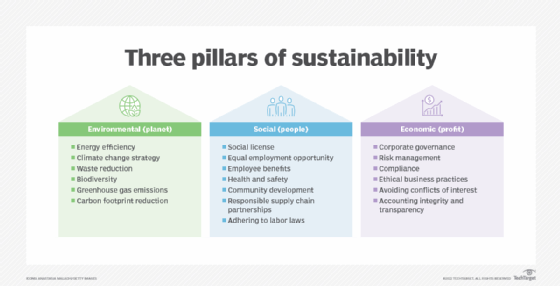
Getty Images
What is the link between sustainability and business continuity?
At first glance, business continuity planning and sustainability efforts might seem separate. But at their core, both aim to create a resilient organization.
In recent years, IT leaders have begun to realize that sustainability and business continuity practices are mutually supportive.
In a nutshell, sustainability aims to address current needs without endangering the ability of future generations to meet theirs. Sustainability is often used synonymously with the term ESG, or environmental, social and governance. ESG frameworks evaluate how well organizations are performing based on particular criteria, such as carbon emissions or diversity, equity and inclusion efforts. Many organizations today are incorporating sustainability and ESG into their overall business strategies. This makes them a natural complement to business continuity and resilience activities.
Like sustainability, business continuity and disaster recovery (BCDR) plans are directly affected by environmental issues such as climate change. As more BCDR teams focus on achieving resilience, taking sustainability into account is a must.
How do business continuity and sustainability intersect?
Business continuity requires that organizations examine current operations for potential risks, threats and vulnerabilities. To achieve resilience and sustainability, organizations must look beyond immediate risks and focus on the long-term survival and performance of the organization. Each activity requires that an organization take a long hard look at its current business strategies, strengths and limitations.
IT leaders and disaster recovery teams can align response, recovery and resumption strategies with the organization's sustainability and ESG initiatives. Connecting these practices is essential to prepare an organization for the future. Failure to do so might result in business disruptions, which can present themselves in a variety of ways.
In recent years, natural disasters, severe weather and supply chain issues have increased in frequency and severity, causing infrastructure damage and fatalities. Damage to the environment is a major cause of operational disruptions.
To understand how business continuity planning can incorporate sustainability efforts, it can help to lay out how it interacts with two of the three elements of an ESG initiative: environmental protection and social issues.

Environmental protection
Organizations have many ways to create more environmentally sustainable operating conditions. These can include efficient power usage, use of environmentally safe products and recycling of equipment. Business continuity plan development should also address environmental issues by identifying ways to improve the sustainability factor in technology, systems and other equipment.
Organizations can also optimize business continuity testing to address environmental issues so that the BCDR teams and senior management can make them a priority during a disruptive incident.
Experience from a disruption can help the organization better understand how to adapt and improve its operations for future events, increasing its resilience. Environmental concerns must be part of these initiatives. IT and DR teams can use what they learned from the incident to adapt operations and find new ways to minimize negative environmental impacts.
Social issues
Business continuity and sustainability plans must address the social impacts, both within and outside of the organization. For example, up-to-date contact data for employees and members of emergency teams is an essential requirement. Emergency teams should understand procedures contained within such plans and communicate them to all employees.
In addition, emergency teams should design and plan testing activities to ensure that personnel are prepared to respond to disruptive events. Employees must know how to evacuate the building, where they should assemble and who they should contact for information regarding the incident.
Considering how widespread social media is today, it has become a highly important part of business continuity and sustainability plans. Social media is often a key component in the incident response process, serving alongside emergency notification systems and other alerting mechanisms. When properly aligned with emergency notification activities, communications with family members, and external entities such as the media, social media can make a huge difference in how business continuity and sustainability plans help the organization manage disruptive events.
Paul Kirvan is an independent consultant, IT auditor, and technical writer, editor and educator. He has more than 25 years of experience in business continuity, disaster recovery, security, enterprise risk management, telecom and IT auditing.





